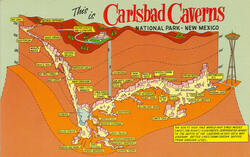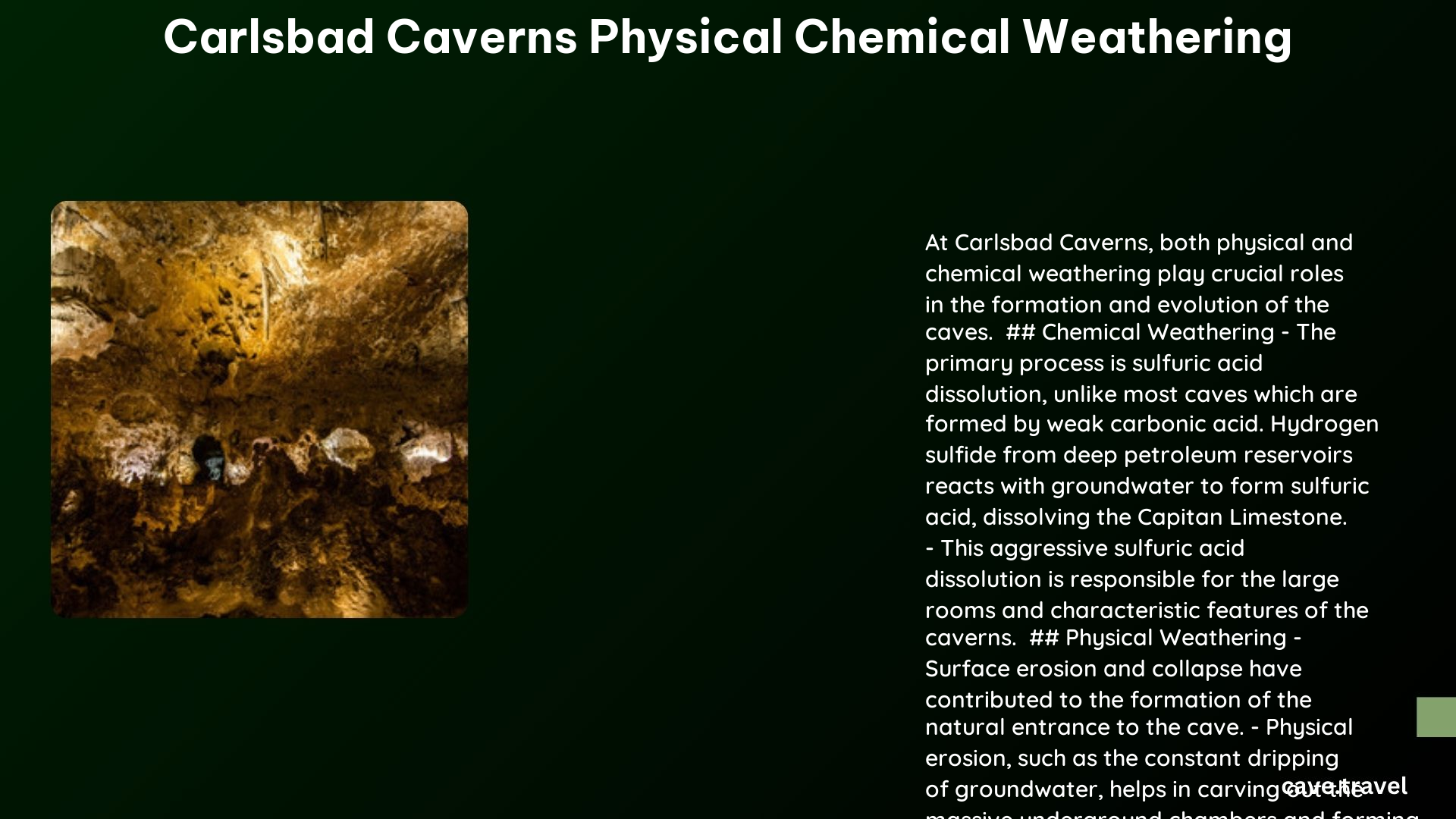Carlsbad Caverns, a remarkable underground wonder, formed through intricate physical and chemical weathering processes. Limestone dissolution by acidic water, particularly sulfuric acid, played a crucial role. This unique combination of weathering mechanisms created vast chambers and intricate formations. Physical processes like collapse and erosion further shaped the caverns, resulting in the awe-inspiring natural landmark we see today.
What Are the Primary Chemical Weathering Processes in Carlsbad Caverns?

The chemical weathering in Carlsbad Caverns is primarily driven by two key processes:
- Carbonic Acid Dissolution
- Sulfuric Acid Dissolution
How Does Carbonic Acid Dissolution Work?
Carbonic acid dissolution is a common process in limestone caves:
- Rainwater absorbs carbon dioxide from the atmosphere and soil
- This forms a weak carbonic acid solution
- The acidic water slowly dissolves the limestone as it percolates through the rock
What Makes Sulfuric Acid Dissolution Unique to Carlsbad Caverns?
Sulfuric acid dissolution sets Carlsbad Caverns apart from many other cave systems:
- Hydrogen sulfide from deep petroleum reservoirs migrates upward
- It reacts with groundwater to form sulfuric acid
- This stronger acid aggressively dissolves the Capitan Limestone
- The process creates larger rooms and caverns more rapidly than carbonic acid alone
What Physical Weathering Processes Contribute to Cave Formation?

Physical weathering plays a significant role in shaping Carlsbad Caverns through several mechanisms:
- Collapse and Erosion
- Fracture and Joint Expansion
How Did Collapse and Erosion Shape the Cave Entrance?
The natural entrance to Carlsbad Cavern formed through:
- Collapse of the cave’s upper sections
- Surface erosion exposing the underlying limestone
- These processes occurred within the last few million years
- The exposed limestone became vulnerable to further chemical weathering
What Role Do Fractures and Joints Play in Cave Development?
Fractures and joints in the limestone contribute to cave formation:
- Water moves through existing cracks and joints
- Over time, this movement expands these openings
- Enlarged fractures allow more acidic water to penetrate deeper
- The process is enhanced by highly permeable fracture zones in the limestone
How Do Environmental Factors Influence Weathering Rates?
Several environmental factors affect the rate of weathering in Carlsbad Caverns:
| Factor | Influence on Weathering |
|---|---|
| Temperature | Affects chemical reaction rates and water solubility |
| Humidity | Impacts evaporation and condensation processes |
| Groundwater Presence | Determines the availability of water for dissolution |
| CO2 Concentration | Affects the acidity of water and dissolution rates |
| Air Flow | Influences evaporation and CO2 exchange |
What Measurements and Observations Support Our Understanding of Cave Processes?
Researchers have conducted various studies to better understand the processes at work in Carlsbad Caverns:
- Air Flow and Humidity Studies:
- Annual variations in air temperature and relative humidity
-
Impact on speleothem formation and ongoing dissolution
-
Groundwater Contamination Analysis:
- Absence of significant soil zone above the cave
- Presence of highly permeable fracture zones
-
Vulnerability to surface contamination
-
Speleothem Orientation:
- Direction of popcorn formations indicates air flow patterns
-
Helps understand the cave’s microclimate
-
Radon Concentration Measurements:
- Used to infer air movement within the caverns
How Do These Processes Influence Cave Formation Mechanisms?
The combination of chemical and physical weathering processes has resulted in Carlsbad Caverns’ unique features:
-
Large Rooms: The aggressive sulfuric acid dissolution created vast chambers like the Big Room, North America’s largest cave chamber.
-
Diverse Speleothems: Ongoing dissolution and deposition processes form various cave formations:
- Stalactites
- Stalagmites
- Flowstone
-
Popcorn formations
-
Complex Cave System: The interplay of different weathering mechanisms has produced an extensive and intricate network of passages and rooms.
What Are the Quantifiable Effects of Limestone Dissolution?
While specific rates for Carlsbad Caverns are not provided in the sources, we can understand the general trends:
- Sulfuric acid dissolution is more rapid than carbonic acid dissolution
- Dissolution rates vary based on:
- CO2 concentration
- Water flow rate
-
Presence of sulfuric acid
-
Environmental conditions significantly impact weathering processes:
- Annual temperature variations
- Relative humidity changes
- Groundwater availability
How Does the Cave’s Geology Affect Its Vulnerability to External Influences?
Carlsbad Caverns’ unique geology makes it susceptible to external factors:
- Thin Soil Cover:
- Limited soil zone above the cave system
-
Reduced natural filtration of surface water
-
Fracture Zones:
- Highly permeable areas in the limestone
-
Allow for rapid water movement and potential contaminant transport
-
Surface-Cave Connections:
- Natural entrance and other openings
- Facilitate air exchange and potential introduction of surface pollutants
These factors highlight the importance of careful management and protection of the cave environment to preserve its unique features and ongoing geological processes.
References:
– https://www.nps.gov/cave/learn/nature/geologicformations.htm
– https://npshistory.com/publications/cave/nrr-2007-003.pdf
– https://www.nps.gov/subjects/caves/solution-caves.htm
